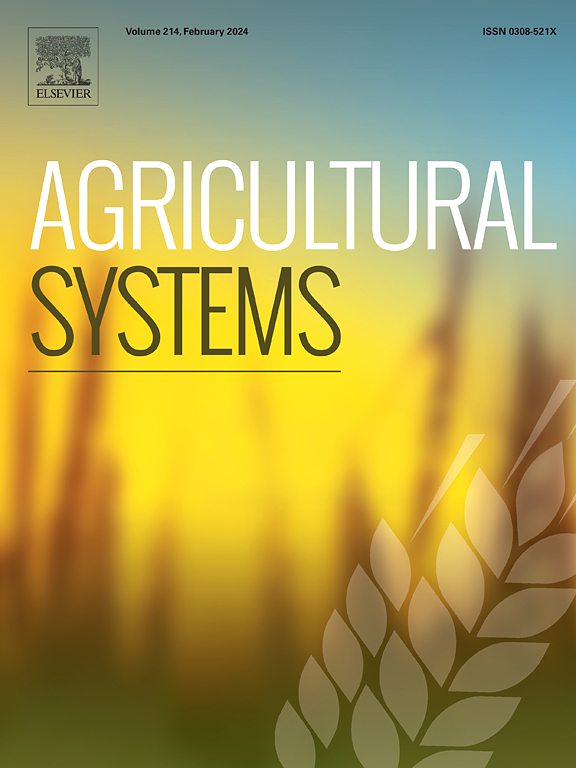基于WHCNS模型的湖北省水稻产量和氮损失区域模拟
IF 6.1
1区 农林科学
Q1 AGRICULTURE, MULTIDISCIPLINARY
引用次数: 0
摘要
过量施氮导致了严重的环境问题。研究水稻产量和氮素损失的空间分布对确定最佳氮肥管理至关重要。然而,以往的研究大多基于田间尺度,缺乏区域尺度的田间管理、土壤和作物信息,难以利用模型方法探索水稻产量和氮流失的空间分布及其影响因素。本文章由计算机程序翻译,如有差异,请以英文原文为准。

Regional modelling of rice yields and nitrogen loss in Hubei Province using the WHCNS model
CONTEXT
Excessive nitrogen (N) fertilization has led to serious environmental problems. Exploring the spatial distribution of rice yields and N loss is crucial to determine optimal N fertilizer management. However, previous studies are mostly based on field scale, it's a big challenge to use model approach to explore the spatial distribution and influencing factors of rice yields and N loss due to lack of field management, soil and crop information at regional scale.
OBJECTIVE
This study aims to evaluate the feasibility of the WHCNS (soil Water Heat Carbon Nitrogen Simulator) model in simulating rice yield and N loss at regional scale, explore the spatial distribution of yield and N loss under traditional water and N management, and determine the main factors causing spatial differences in Hubei Province.
METHODS
The WHCNS model was calibrated and validated using data collected on statistical yields and N losses in Hubei Province. Then, the model was used to simulate rice yield and NH3 volatilization, denitrification, N leaching and runoff for single, early and late season rice at regional scale. The spatial distribution of yield and N loss and their correlation with meteorological factors and soil properties were analyzed.
RESULTS AND CONCLUSIONS
The WHCNS model performed well in simulation of regional rice yield and N loss compared with other models. R2 and d of simulated and measured yields, ammonia volatilization and N runoff were > 0.55 and 0.84 respectively. The yield was higher in central Hubei and lower in western and southeastern Hubei, mainly driven by solar radiation and temperature, soil clay content, pH and bulk density. N runoff loss decreased from east to west of Hubei, mainly affected by rainfall and temperature for single and early season rice, and bulk density for late season rice. Higher N leaching and denitrification in northwestern Hubei were related to high nutrient content (soil total N and organic matter) and poor aeration. Higher NH3 emission was found in eastern Hubei, mainly affected by temperature and precipitation. The average total N loss for single, early and late season rice was 77.2, 65.6, and 81.5 kg N ha−1, respectively, accounting for 33.6 %, 31.5 %, and 40.8 % of the N application rates.
SIGNIFICANCE
The WHCNS model was used to determine the spatial distribution and main factors influencing rice yields and N loss in Hubei Province. These findings provide a scientific basis for optimizing N management to minimize N loss while maintaining yield.
求助全文
通过发布文献求助,成功后即可免费获取论文全文。
去求助
来源期刊

Agricultural Systems
农林科学-农业综合
CiteScore
13.30
自引率
7.60%
发文量
174
审稿时长
30 days
期刊介绍:
Agricultural Systems is an international journal that deals with interactions - among the components of agricultural systems, among hierarchical levels of agricultural systems, between agricultural and other land use systems, and between agricultural systems and their natural, social and economic environments.
The scope includes the development and application of systems analysis methodologies in the following areas:
Systems approaches in the sustainable intensification of agriculture; pathways for sustainable intensification; crop-livestock integration; farm-level resource allocation; quantification of benefits and trade-offs at farm to landscape levels; integrative, participatory and dynamic modelling approaches for qualitative and quantitative assessments of agricultural systems and decision making;
The interactions between agricultural and non-agricultural landscapes; the multiple services of agricultural systems; food security and the environment;
Global change and adaptation science; transformational adaptations as driven by changes in climate, policy, values and attitudes influencing the design of farming systems;
Development and application of farming systems design tools and methods for impact, scenario and case study analysis; managing the complexities of dynamic agricultural systems; innovation systems and multi stakeholder arrangements that support or promote change and (or) inform policy decisions.
 求助内容:
求助内容: 应助结果提醒方式:
应助结果提醒方式:


